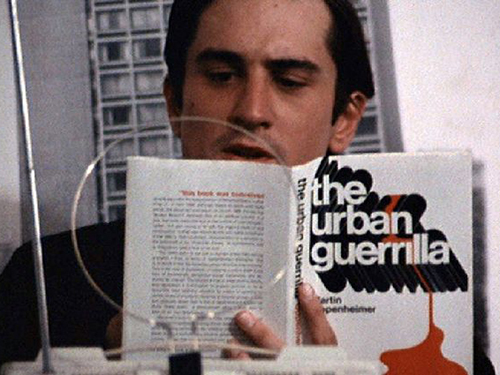
“In Hi, Mom!, the Be Black, Baby theater performance is being filmed as part of a documentary for educational television. Just as the theater patrons become so involved that they begin to believe the play’s events are really happening, viewers of the TV program are drawn in by the documentary’s ‘reality effect’ to the point where reel images come to seem real. This effect is fostered by the grainy black-and-white used for the film, which resembles true-life news footage, and by the improvisational feel of the performance, which is shot in what appears to be one take, as if events were unfolding unpredictably in real time. De Palma compounded this “reality effect” by casting actual Black Power activists in key roles: ‘I try to use very real people. Like in [Hi, Mom!], we have a black militant. Not an actor. But a young kid who’s radical and who’s not playacting.’ When a gun is pointed at the male theater patron who tries to intervene in the woman’s rape, it is also pointed at the cameraman and by extension the TV viewer, who are equally made to believe that they must now experience what it is like to be helpless witnesses to a physical assault on one of their own.
But the black troupe’s Theater of Cruelty and the harrowing TV documentary both fail to shock audiences out of their complacency as distant spectators and into some greater empathy with black experience, which might have truly altered understanding and changed society. Once they have arrived safely outside the ‘environmental theater’ in which they had been robbed and raped, the white playgoers quickly reduce their harrowing experience to just another show. ‘[New York Times theater critic] Clive Barnes was really right,’ they rave. ‘It was a great show, great theater!’ ‘I’m tickled I came,’ says one audience member, diminishing and dismissing the impact of the violent event, while another proceeds to intellectualize the whole thing away: ‘It really makes you stop and think.’ When the TV documentary of Be Black, Baby concludes to the tune of soothing classical music (‘music to write checks by,’ in the words of the announcer), it is implied that TV viewers ultimately have the same dismissive reaction to what they witnessed as the theatergoers from suburbia did to their inner-city black ‘show.’ As De Palma said: ‘I was really trying to show how you lie with documentaries, those ridiculous documentaries you see on educational TV all the time about the oppressed blacks, made by white middle-class film makers. They’re being oppressed by the economics of that class, yet these people are running around saying, “Don’t worry, it’s all going to be okay. Here are your food stamps.”’”
Douglas Keesey1
“If indeed De Palma’s own auto-critique of Hi, Mom! in relation to his own personal canon was informed by what wags sarcastically refer to as the ‘Hitchcock connection’ (derisively calling to mind images of De Palma fixed on the belly of the Master of Suspense like a lamprey or via an umbilical cord) and that this early counter-cultural comedy somehow falls short on the required tally of Hitch riffs, it would be a shame. Hi, Mom! might have been only the third feature film by the director, but practically every trait that would come to signify the art of De Palma is at play in the film, many of them, natch, in direct conflict with another.
The most Hitchcockian riff that De Palma ever examined is the capacity for the human psyche to harbor intense, complicated divergence. But, whereas Hitchcock often resolved this tension by placing it in the context of a relatively well adjusted, normalized society (i.e. the long-winded psychological rationale that closes Psycho), De Palma complicates the archetype through his insistence on highlighting the equally labyrinthine tangle of contradictions behind social normalcy, knots that seem to cause individual maladaptive dysfunction. An early broadcast from NIT (that’s National Intelligent Television, the front used by the anarchist theater clan) sees the crew of black students taking to the streets with the intention of exposing the internal hypocrisies of the average WASP. Obviously baiting people to their breaking points, the students reveal the sham of social grace, as their targets are stripped of their reliable defense (their politeness and tacitly segregated racial congregations). This sequence is obviously the comedic setup for the Be Black, Baby performance art nightmare that practically rapes the definition of social façades and the lengths people will go to preserve them. But it’s also a reflection of Jon’s demented internal logic (to the extent that a cipherous figure can be said to have logic); in De Palma’s world he is portrayed as a man whose utter alienation from normalcy stems, appropriately enough, from the total absence of it.”
Eric Henderson2
- 1Douglas Keesey, Brian De Palma’s Split-Screen. A Life in Film (Jackson: University Press of Mississippi, 2015), 56-57.
- 2Eric Henderson, “Film review: Hi, Mom!,” Slant Magazine, 11 June 2004.

